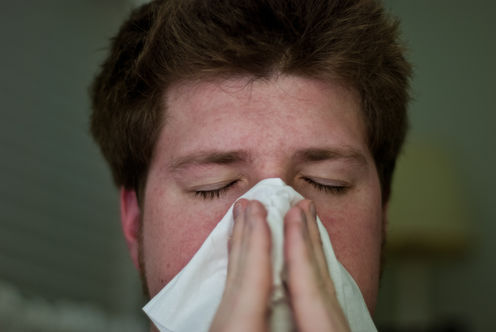
We tend to notice mucus only when it’s abnormal and the sticky fluid is expelled from orifices. But actually it’s pretty amazing stuff. Every moment of our lives mucus is protecting our internal organs, including the sexual organs and bowels. Here, though, we’ll focus on the airways.
What is mucus?
Mucus is 95% water, 3% proteins (including mucin and antibodies), 1% salt and other substances. Mucin droplets absorb water and swell several hundred times in volume within three seconds of release from mucus glands. Mucus strands form cross links, producing a sticky, elastic gel.
The solid gel layer acts as a physical barrier to most pathogens and the constant flushing movement prevents the establishment of bacterial biofilms. However, the pore size of the gel mesh means small viruses can easily penetrate it.
Anatomy of the airways
Both nasal cavities combined have a surface area of 150 square centimetres, aided by bony folds on their side walls. The turbulent airstream means 80% of particles are filtered here, so the adhesive properties of mucus are vital.
The blood flow to the nose varies with changing outside temperature, acting like a reverse-cycle air conditioner for the lungs.
Mucus is constantly produced (although in lesser quantities during sleep) and moved along. The mucus carries with it dead cells and other dust and debris, ending up in the stomach for recycling.
Many cells lining the airways have a long, tail-like hair, called cilia. Cilia beat at ten to 12 times per second, propelling mucus at one millimetre per minute.
Lung airways also have cilia, working hard to move mucus uphill against gravity. Mucus from the lungs is sometimes termed “phlegm”, and then “sputum” once it has been spat out.
The nose produces over 100 millilitres of mucus a day and the lungs produce approximately 50 millilitres daily.
Mucus and airways disease
Mucus assists in fighting infection when white blood cells and antibodies are excreted into the mucus film. The amount of mucus and watery liquid is increased to flush away infection, irritants or allergens.
Viruses that damage respiratory lining cells also damage cilia, so a runnier mucus layer is more easily propelled. When the cilia just can’t keep up, the body deploys other strategies such as coughing, blowing the nose, sneezing and every parent’s favourite, the snotty nose.
Chronic lung disease such as chronic bronchitis and cystic fibrosis cause mucus glands to multiply three to four times above normal levels, resulting in more viscous mucus that the cilia can’t easily clear.

Dehydration and some medications such as nasal decongestants reduce the effectiveness of cilia by lowering the ciliary beat frequency.
Even a frequent and repetitive cough can fatigue the cilia, leading to slower transit and increased stickiness of the mucus. That’s why many people have a prolonged “post-nasal drip” cough after colds and hay fever, as the mucus that has dripped down from the back of the nasal cavity isn’t cleared.
Saline (salt solutions) increase ciliary beat frequency and have demonstrated benefit in respiratory disease, from sinusitis to cystic fibrosis.
A ‘chesty cough’?
There is a common belief that a moist (chesty) cough indicates a chest infection. But in young, healthy people, post-nasal drip of mucus is more common than bronchitis or a chest infection.
It is extremely difficult to judge whether the sputum in the throat arose in the lungs or dripped down from the back of the nasal cavity. And mucus vibrating near the vocal cords sounds chesty no matter where it came from.
But the timing of cough may be helpful for diagnosis: a post-nasal drip cough is worse when lying down and for a while after rising from bed in the morning.
Green phlegm
Another misconception is that green mucus indicates bacterial infection and thus requires antibiotic treatment.
A number of research studies have shown poor correlation between mucus colour and significant infection. The yellow and green colours actually come from white blood cells (leucocytes) that fight infection, but are also more prominent the longer the mucus has “stuck around for”. So morning sputum may be more coloured than later in the day.
The diagnosis of a bacterial infection is made when a combination of symptoms and findings exists, with mucus colour not being the most important of these.
Unfortunately this misconception extends to some GPs. Patients with green sputum are prescribed antibiotics three times more often than patients coughing clear sputum. However, for patients with a bad cough, this prescription did not improve their recovery.

Mucus can be colourful stuff, extending from clear to yellowy-green, but also orange, brown and grey.
Orange and brown comes from the presence of blood in mucus, of variable concentrations and ages. This blood commonly comes from the nose, due to inflammation, infection or side effects of nasal medication, without an obvious nose bleed.
Blood-stained sputum from the lungs may indicate a more serious illness.
Milk and mucus
Many people believe milk and dairy products stimulate the production of extra mucus, so should be avoided in those with hay fever and asthma. This perception arises from the short-term change in consistency of mucus and saliva in the mouth and throat.
But research evidence shows no difference in measured mucus output. Another “blinded” study compared identical-looking dairy and soy products and found no difference in amount or perception of mucus.
To spit or swallow?
I’m occasionally asked whether swallowing mucus produced with a respiratory infection is harmful. It’s not; luckily the stomach works to neutralise bacteria and recycle the other cellular debris.
Some people do report a queasy feeling in the stomach during such infections. This is more likely due to air swallowed from repeated throat clearing and the infection itself, rather than increased mucus getting to the stomach.
Freelance journalist and translator Claire Dupré assisted with the drafting of this article.
David King does not work for, consult to, own shares in or receive funding from any company or organisation that would benefit from this article, and has no relevant affiliations.
